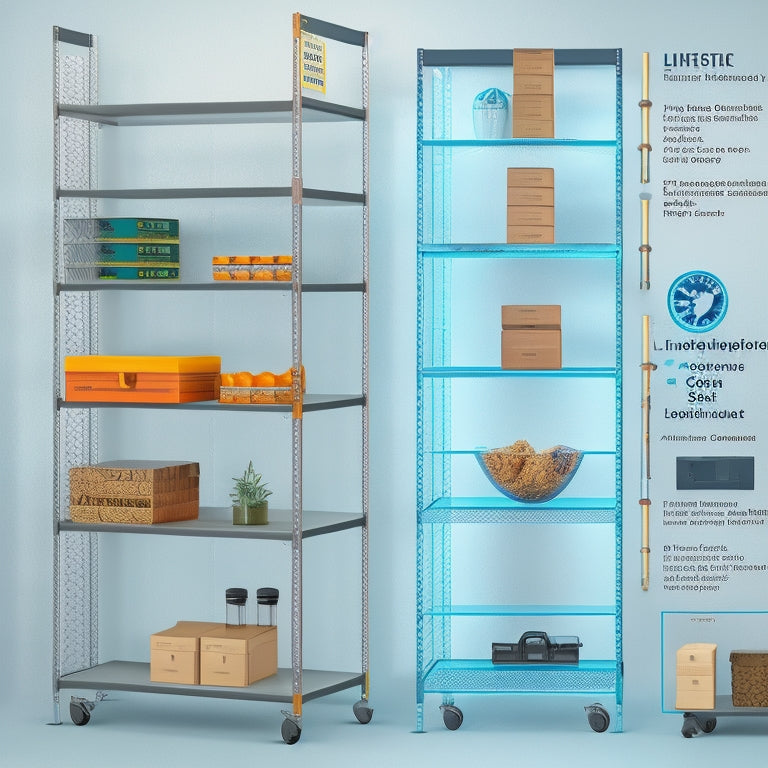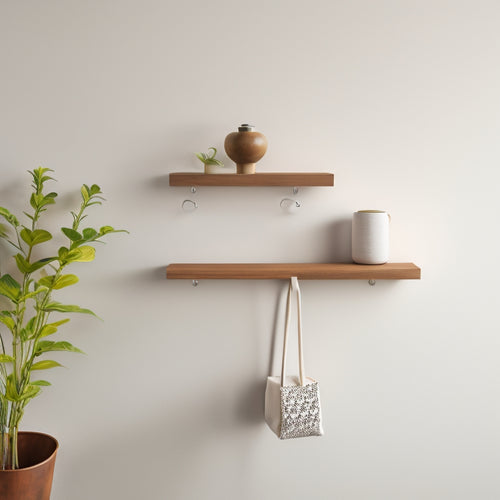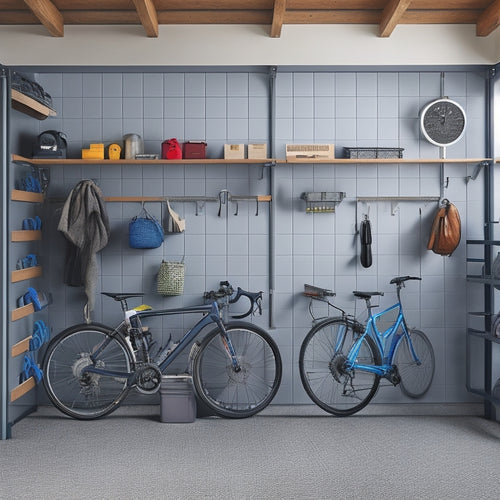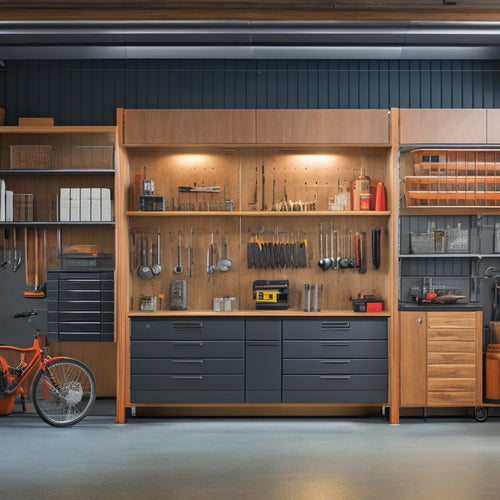
Key Components of a Rack Shelving System
Share
When implementing a rack shelving system, you'll need to take into account several key components. The frame and post construction form the structural foundation, with uprights and columns designed to withstand lateral forces and support weight. Shelving levels and decks are also essential, with decking material options like wire mesh or solid shelves, and adjustable shelving for varying item sizes. Additionally, beam and connector types, such as step, box, or structural beams, and connector styles like bolted or welded, guarantee load capacity and durability. As you investigate these components, you'll learn how they work together to create a safe, efficient, and customized storage solution that meets your unique needs.
Key Takeaways
- A sturdy frame and structural components, including uprights and columns, provide the foundation for a reliable rack shelving system.
- Shelving and decking components, such as wire mesh or solid shelves, must be selected based on weight capacity, item size, and environmental factors.
- Load capacity and safety features, including weight distribution, load testing, and ergonomic design, are critical to preventing accidents and protecting inventory.
- Leveling and adjustment systems, including mechanisms for uneven floors and shelf spacing adjustments, ensure stability and maximize storage capacity.
- Beam and connector systems, including beam types and connector styles, must be chosen based on load capacity, durability, and adjustability to ensure a functional and customizable system.
Frame and Post Construction
With the foundation of your rack shelving system laid out, you're ready to construct the frame and post. This critical step guarantees the overall frame stability of your system.
Start by assembling the uprights, which will form the vertical columns of your frame. Make sure to securely anchor them to the floor to prevent the system from tipping over.
Next, attach the horizontal beams to the uprights, creating a sturdy rectangular frame. The post height should be carefully planned to accommodate the maximum weight capacity and desired shelving levels.
Confirm the posts are level and plumb to maintain the structural integrity of the system. Properly secure the frame components together using bolts, screws, or welding, depending on the system's design.
A well-constructed frame and post will provide a solid base for your rack shelving system, ensuring the safety of personnel and materials.
Shelving Levels and Decks
You'll need to evaluate the decking material options, such as wire mesh or solid shelves, to guarantee the shelving levels can support the weight of your stored items.
You'll also need to think about shelf spacing adjustments to accommodate varying item sizes.
Additionally, a well-designed leveling system will help you maintain stability and prevent uneven weight distribution across the shelving levels.
Decking Material Options
Decking material options for shelving levels and decks comprise a crucial aspect of the rack shelving system, as they directly impact the overall functionality, safety, and durability of the structure.
You need to evaluate various factors, including decking durability, aesthetics, and maintenance requirements, to guarantee your rack shelving system meets your specific needs.
When selecting decking materials, you should assess the following key factors:
-
Decking compatibility: Verify the decking material is compatible with the rack shelving system's frame and any other components.
-
Decking weight: Choose a decking material that can support the weight of the items you plan to store, as well as any additional weight from shelving or other components.
-
Decking insulation: Consider decking materials with insulation properties to maintain a consistent temperature and reduce energy costs.
- Decking installation: Select a decking material that's easy to install, reducing the risk of errors and guaranteeing a safe working environment.
Shelf Spacing Adjustments
Optimizing shelf spacing adjustments for shelving levels and decks is vital to maximizing storage capacity, guaranteeing efficient inventory management, and promoting a safe working environment.
When designing your shelf spacing, consider the shelf height and adjustment mechanisms that allow for user customization. This flexibility enables you to accommodate varying inventory sizes and optimize storage efficiency. Proper load management is also essential, as it guarantees weight distribution across the shelf and prevents damage or collapse.
When installing your shelves, follow these guidelines:
| Shelf Spacing Guidelines | Recommended Spacing |
|---|---|
| Light-duty storage (less than 50 lbs) | 12-18 inches |
| Medium-duty storage (50-100 lbs) | 18-24 inches |
| Heavy-duty storage (over 100 lbs) | 24-36 inches |
| Specialized storage (e.g., pallets) | Customized spacing based on pallet size |
Remember to maintain proper shelf alignment and follow installation tips to guarantee a secure and stable shelving system. Regular maintenance practices, such as checking for wear and tear, will also extend the lifespan of your rack shelving system.
Leveling System Design
Proper shelf spacing adjustments set the stage for a well-designed leveling system, which guarantees that shelving levels and decks are precisely aligned and secure.
You'll want to verify that your leveling system design takes into account the unique requirements of your storage environment.
When designing your leveling system, consider the following key factors:
-
Leveling mechanisms: Choose mechanisms that can be easily adjusted to accommodate uneven floors or changes in shelving loads.
-
Installation techniques: Confirm that your installation techniques account for potential settlement or shifting of the shelving system over time.
-
Shelving level alignment: Verify that shelving levels are precisely aligned to prevent load shifting or collapse.
- Decking material selection: Select decking materials that can withstand the weight and type of items being stored.
Beam and Connector Types
How do you guarantee the stability and strength of your rack shelving system? It starts with selecting the right beam and connector types.
There are various beam types to choose from, including step beams, box beams, and structural beams. Each type has its own unique characteristics, such as load capacity, durability, and adjustability. For instance, step beams are ideal for storing small items, while box beams provide added strength and stability for heavier loads.
When it comes to connector styles, you have options like bolted, welded, or clip-in connectors. Bolted connectors offer flexibility and ease of assembly, while welded connectors provide added strength and security.
Clip-in connectors, on the other hand, allow for quick and easy installation. Regardless of the type you choose, it's crucial to verify that your connectors are designed to withstand the weight and stress of your stored items.
Upright and Column Design
You've selected the right beam and connector types, now it's time to focus on the upright and column design of your rack shelving system. This critical component guarantees your system's stability and safety. A well-designed upright and column structure provides the foundation for your rack shelving system, supporting the weight of your stored items and withstanding various environmental factors.
When designing your upright and column structure, consider the following key factors:
-
Upright stability: Ascertain your uprights are designed to withstand lateral forces and maintain their stability, even when subjected to external pressures.
-
Column strength: Select columns that can support the weight of your stored items and the rack's structural components, assuring the system's overall strength and durability.
-
Material selection: Choose materials that offer the necessary strength, durability, and resistance to corrosion, guaranteeing your system remains safe and functional over time.
- Dimensional accuracy: Verify that your uprights and columns are precision-engineered to ascertain a snug fit, eliminating any potential weakness or instability in the system.
Footplate and Anchor Options
Frequently, the overlooked yet vital components of a rack shelving system are the footplates and anchors. You must consider the footplate design, as it directly affects the system's stability and load capacity. Make sure the footplate is designed to distribute the weight of the rack evenly, preventing it from tipping or shifting.
You'll need to choose from various anchor types, such as concrete anchors or lag bolts, depending on the surface finish of your floor. Proper installation techniques are essential to guarantee the anchors hold the rack securely in place. Remember to follow safety regulations and manufacturer guidelines to avoid accidents and injuries.
During maintenance, regularly inspect the footplates and anchors for signs of wear or damage. Replace them promptly if you notice any issues.
Compatibility with your rack's upright and column design is also important. Verify that the footplate and anchor options you choose are compatible with your system to ensure peak performance and safety.
Shelving Material and Finish
You'll need to take into account the type of material for your shelving, with options including metal and plastic, each with its own set of benefits and drawbacks.
The finish of your shelving is also essential, and a durable powder coat finish can provide a long-lasting, corrosion-resistant solution.
Metal and Plastic Options
Shelving material and finish play an essential role in determining the durability, functionality, and aesthetic appeal of a rack shelving system. When it comes to choosing the right material, you'll want to take into account the specific needs of your application.
You have two primary options: metal and plastic.
-
Metal Durability: Metal shelving is ideal for heavy-duty applications where maximum strength and stability are vital. Its durability guarantees that your rack shelving system can withstand heavy loads and harsh environments.
-
Plastic Flexibility: Plastic shelving, on the other hand, offers flexibility and versatility. It's perfect for lighter loads and can be easily rearranged or reconfigured as your needs change.
-
Corrosion Resistance: If you're working in a humid or wet environment, think about a material with corrosion-resistant properties to prevent rust or damage.
- Aesthetics: Finally, contemplate the overall look and feel you want to achieve. Both metal and plastic shelving come in a range of finishes and colors to suit your specific needs.
Durable Powder Coat Finish
Most rack shelving systems benefit from a sturdy powder coat finish, which provides exceptional resistance to corrosion, scratches, and fading. This finish is a popular choice for industrial and commercial applications due to its durability and low maintenance requirements.
You'll appreciate the wide range of color options available, allowing you to customize your rack shelving system to fit your brand or facility's aesthetic.
In terms of maintenance, a powder coat finish is relatively easy to care for. Simply wipe down the shelves with a mild detergent and water to remove dirt and debris. Avoid using harsh chemicals or abrasive cleaners, as these can damage the finish over time.
From an environmental viewpoint, powder coat finishes are a more eco-friendly option compared to traditional liquid coatings, as they produce minimal VOCs (volatile organic compounds).
You'll find powder coat finishes commonly used in warehouses, manufacturing facilities, and distribution centers. They're particularly well-suited for applications where shelves will be subject to heavy use or harsh environmental conditions.
Load Capacity and Rating
Two critical aspects of any rack shelving system are its load capacity and rating, which directly impact the safety and efficiency of your storage operation.
When selecting a rack shelving system, you must consider the maximum weight it can safely hold to prevent accidents and damage to your inventory.
To guarantee you're getting the right system for your needs, look for the following key factors that affect load capacity and rating:
-
Weight distribution: How evenly the weight is distributed across the shelves and beams affects the overall load capacity of the system.
-
Load testing: The system should undergo rigorous testing to determine its maximum load capacity and verify it meets industry standards.
-
Material strength: The quality and strength of the materials used in the system's construction directly impact its load capacity and rating.
- Design and configuration: The design and configuration of the system, including the type and number of shelves, beams, and uprights, also impact its load capacity and rating.
Accessibility and Safety Features
Once you've confirmed your rack shelving system can handle the required load capacity, it's equally important to take into account how easily you can access and manage your inventory while maintaining a safe working environment.
This is where accessibility and safety features come into play. A well-designed rack shelving system should prioritize ergonomic design to reduce the risk of injury and fatigue. Look for systems with adjustable shelving heights, spacious aisles, and easy-to-use storage bins to facilitate efficient inventory management.
Moreover, verify your rack shelving system complies with relevant safety regulations, such as OSHA guidelines, to prevent accidents and injuries. Features like sturdy frames, secure shelving, and weight capacity labels can help prevent collapses and other hazards.
Additionally, consider incorporating safety features like anti-tip brackets, floor anchors, and seismic restraints to further minimize risks. By prioritizing accessibility and safety, you can create a productive and secure workspace that protects your employees and inventory.
Customization and Add-Ons
Flexibility is key when it comes to maximizing the efficiency of your rack shelving system. You need a system that can adapt to your changing storage needs.
That's where customization and add-ons come in. With adjustable shelves, you can modify the shelf height to accommodate items of varying sizes, ensuring ideal use of storage space.
Modular designs allow you to add or remove components as needed, giving you the flexibility to reconfigure your system to suit your developing storage requirements.
Consider the following customization options:
- Shelf dividers: Separate items on the same shelf to prevent damage and make inventory management easier.
- Bin storage: Add bins or containers to store small parts or accessories, keeping them organized and within reach.
- Label holders: Attach label holders to shelves or bins to identify contents quickly and accurately.
- Security features: Integrate security features, such as locks or access controls, to restrict access to sensitive or precious items.
Frequently Asked Questions
Can I Install a Rack Shelving System on an Uneven Floor?
You can install a rack shelving system on an uneven floor, but you'll need to evaluate floor factors, such as slope and cracks, and investigate leveling options, like shims or adjustable feet, to guarantee a stable and safe installation.
How Often Should I Inspect and Maintain My Rack Shelving System?
You should inspect your rack shelving system regularly, ideally every 3-6 months, to guarantee stability and safety. Implement maintenance best practices, like tightening loose bolts and cleaning debris, to prevent accidents and prolong the system's lifespan.
Are Rack Shelving Systems Compatible With Automated Storage Systems?
You'll find that rack shelving systems can seamlessly integrate with automated storage systems, enabling automated integration that enhances storage efficiency and maximizes your warehouse's potential, while ensuring a safe and organized environment for your operations.
Can I Use a Rack Shelving System for Outdoor Storage?
You can use a rack shelving system for outdoor storage if you choose one designed with outdoor durability and weather resistance in mind, ensuring the structure can withstand harsh conditions and maintain safety standards.
Do Rack Shelving Systems Come With a Warranty or Guarantee?
You expect reliability and protection, and rightly so! Most rack shelving systems come with warranty options, typically ranging from 1-5 years, offering peace of mind with their warranty duration, so you can store with confidence.
Conclusion
As you've built your rack shelving system, each component has fallen into place like a expertly crafted puzzle. The frame and posts provide the foundation, shelving levels and decks the storage, beams and connectors the support, uprights and columns the strength, footplates and anchors the stability, and shelving material and finish the durability. Now, your system stands tall, a fortress of organization, with load capacity and rating its shield, accessibility and safety features its gates, and customization and add-ons its crowning glory.
Related Posts
-

Wall Mounted Hooks With Shelf for Maximum Storage
You'll find that wall mounted hooks with a shelf are a revolutionary solution for maximizing storage in your home, pr...
-

Key Features of a Garage Wall Hanging System
You're looking for a garage wall hanging system that's built to last and adapts to your needs. Look for systems made ...
-

Best Materials for Garage Wall-Mounted Cabinets
When selecting materials for your garage wall-mounted cabinets, you'll want to evaluate options that balance durabili...


